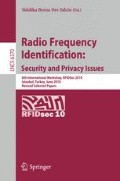Abstract
In this paper, we classify the RFID distance bounding protocols having bitwise fast phases and no final signature. We also give the theoretical security bounds for two specific classes, leaving the security bounds for the general case as an open problem. As for the classification, we introduce the notion of k-previous challenge dependent (k-PCD) protocols where each response bit depends on the current and k-previous challenges and there is no final signature. We treat the case k = 0, which means each response bit depends only on the current challenge, as a special case and define such protocols as current challenge dependent (CCD) protocols. In general, we construct a trade-off curve between the security levels of mafia and distance frauds by introducing two generic attack algorithms. This leads to the conclusion that CCD protocols cannot attain the ideal security against distance fraud, i.e. 1/2, for each challenge-response bit, without totally losing the security against mafia fraud. We extend the generic attacks to 1-PCD protocols and obtain a trade-off curve for 1-PCD protocols pointing out that 1-PCD protocols can provide better security than CCD protocols. Thereby, we propose a natural extension of a CCD protocol to a 1-PCD protocol in order to improve its security. As a study case, we give two natural extensions of Hancke and Kuhn protocol to show how to enhance the security against either mafia fraud or distance fraud without extra cost.
Access this chapter
Tax calculation will be finalised at checkout
Purchases are for personal use only
Preview
Unable to display preview. Download preview PDF.
References
Avoine, G., Floerkemeier, C., Martin, B.: RFID Distance Bounding Multistate Enhancement. In: Roy, B., Sendrier, N. (eds.) INDOCRYPT 2009. LNCS, vol. 5922, pp. 290–307. Springer, Heidelberg (2009)
Avoine, G., Tchamkerten, A.: An Efficient Distance Bounding RFID Authentication Protocol: Balancing False-acceptance Rate and Memory Requirement. In: Samarati, P., Yung, M., Martinelli, F., Ardagna, C.A. (eds.) ISC 2009. LNCS, vol. 5735, pp. 250–261. Springer, Heidelberg (2009)
Beth, T., Desmedt, Y.: Identification Tokens - or: Solving the Chess Grandmaster Problem. In: Menezes, A., Vanstone, S.A. (eds.) CRYPTO 1990. LNCS, vol. 537, pp. 169–177. Springer, Heidelberg (1991)
Brands, S., Chaum, D.: Distance-Bounding Protocols. In: Helleseth, T. (ed.) EUROCRYPT 1993. LNCS, vol. 765, pp. 344–359. Springer, Heidelberg (1994)
Capkun, S., Butty’an, L., Hubaux, J.-P.: SECTOR: Secure Tracking of Node Encounters in Multi-hop Wireless Networks. In: ACM Workshop on Security of Ad Hoc and Sensor Networks, SASN 2003, Fairfax, Virginia, USA, pp. 21–32. ACM Press, New York (October 2003)
Desmedt, Y.: Major security problems with the’ Unforgeable’ (Feige)-Fiat-Shamir proofs of identity and how to overcome them. In: SecuriCom 1988, pp. 15–17 (1988)
Desmedt, Y., Goutier, C., Bengio, S.: Special uses and abuses of the fiat-shamir passport protocol. In: Pomerance, C. (ed.) CRYPTO 1987. LNCS, vol. 293, pp. 21–39. Springer, Heidelberg (1988)
Hancke, G.: A Practical Relay Attack on ISO 14443 Proximity Cards. (February 2005) (manuscript)
Hancke, G., Kuhn, M.: An RFID Distance Bounding Protocol. In: Conference on Security and Privacy for Emerging Areas in Communication Networks, SecureComm 2005, Athens, Greece. IEEE Computer Society Press, Los Alamitos (September 2005)
Hancke, G., Mayes, K., Markantonakis, K.: Confidence in Smart Token Proximity: Relay Attacks Revisited. Elsevier Computers & Security (June 2009)
Kapoor, G., Zhou, W., Piramuthu, S.: Distance Bounding Protocol for Multiple RFID Tag Authentication. In: Proceedings of the 2008 IEEE/IFIP International Conference on Embedded and Ubiquitous Computing, EUC 2008, Shanghai, China, pp. 115–120. IEEE Computer Society Press, Los Alamitos (December 2008)
Kim, C.H., Avoine, G.: RFID distance bounding protocol with mixed challenges to prevent relay attacks. In: Garay, J.A., Miyaji, A., Otsuka, A. (eds.) CANS 2009. LNCS, vol. 5888, pp. 119–133. Springer, Heidelberg (2009)
Kim, C.H., Avoine, G., Koeune, F., Standaert, F.-X., Pereira, O.: The Swiss-Knife RFID Distance Bounding Protocol. In: Lee, P.J., Cheon, J.H. (eds.) ICISC 2008. LNCS, vol. 5461, pp. 98–115. Springer, Heidelberg (2009)
Munilla, J., Peinado, A.: Distance bounding protocols for RFID enhanced by using void-challenges and analysis in noisy channels. Wireless Communications and Mobile Computing 8(9), 1227–1232 (2008)
Nikov, V., Vauclair, M.: Yet Another Secure Distance-Bounding Protocol. Cryptology ePrint Archive, Report 2008/319 (2008)
Reid, J., Gonzalez Neito, J., Tang, T., Senadji, B.: Detecting relay attacks with timing based protocols. In: Bao, F., Miller, S. (eds.) Proceedings of the 2nd ACM Symposium on Information, Computer and Communications Security, ASIACCS 2007, Singapore, Republic of Singapore, pp. 204–213. ACM Press, New York (March 2007)
Singelée, D., Preneel, B.: Distance Bounding in Noisy Environments. In: Stajano, F., Meadows, C., Capkun, S., Moore, T. (eds.) ESAS 2007. LNCS, vol. 4572, pp. 101–115. Springer, Heidelberg (2007)
Tu, Y.-J., Piramuthu, S.: RFID Distance Bounding Protocols. In: First International EURASIP Workshop on RFID Technology, Vienna, Austria (September 2007)
Author information
Authors and Affiliations
Editor information
Editors and Affiliations
Rights and permissions
Copyright information
© 2010 Springer-Verlag Berlin Heidelberg
About this paper
Cite this paper
Kara, O., Kardaş, S., Bingöl, M.A., Avoine, G. (2010). Optimal Security Limits of RFID Distance Bounding Protocols. In: Ors Yalcin, S.B. (eds) Radio Frequency Identification: Security and Privacy Issues. RFIDSec 2010. Lecture Notes in Computer Science, vol 6370. Springer, Berlin, Heidelberg. https://doi.org/10.1007/978-3-642-16822-2_18
Download citation
DOI: https://doi.org/10.1007/978-3-642-16822-2_18
Publisher Name: Springer, Berlin, Heidelberg
Print ISBN: 978-3-642-16821-5
Online ISBN: 978-3-642-16822-2
eBook Packages: Computer ScienceComputer Science (R0)

